 W
WPregnancy, also known as gestation, is the time during which one or more offspring develops inside a woman. A multiple pregnancy involves more than one offspring, such as with twins. Pregnancy usually occurs by sexual intercourse, but can occur through assisted reproductive technology procedures. A pregnancy may end in a live birth, a spontaneous miscarriage, an induced abortion, or a stillbirth. Childbirth typically occurs around 40 weeks from the start of the last menstrual period (LMP). This is just over nine months – where each month averages 31 days. When using fertilization age it is about 38 weeks. An embryo is the developing offspring during the first eight weeks following fertilization, after which, the term fetus is used until birth. Signs and symptoms of early pregnancy may include missed periods, tender breasts, nausea and vomiting, hunger, and frequent urination. Pregnancy may be confirmed with a pregnancy test.
 W
WPregnancy over the age of 50 has, over recent years, become possible for more women, and more easily achieved for many, due to recent advances in assisted reproductive technology, in particular egg donation. Typically, a woman's fecundity ends with menopause, which, by definition, is 12 consecutive months without having had any menstrual flow at all. During perimenopause, the menstrual cycle and the periods become irregular and eventually stop altogether, but even when periods are still regular, the egg quality of women in their forties is lower than in younger women, making the likelihood of conceiving a healthy baby also reduced, particularly after age 42. The female biological clock can vary greatly from woman to woman. A woman's individual level of fertility can be tested through a variety of methods.
 W
WAlcohol use in pregnancy includes use of alcohol during gestation, including the time before the woman is aware of the pregnancy. No amount of alcohol is considered safe to drink while pregnant and there is no safe time point or trimester in pregnancy to drink alcohol. Fetal alcohol spectrum disorders (FASDs) are a group of conditions that can occur in a person whose mother drank alcohol during pregnancy. The most severe form of the condition is known as fetal alcohol syndrome (FAS). Problems may include an abnormal appearance, short height, low body weight, small head size, poor coordination, low intelligence, behavioral problems, hearing loss, and vision problems. Those affected are more likely to have trouble in school, legal problems, participate in high-risk behaviors, and have trouble with alcohol and recreational drug use. Alcohol use during pregnancy also can cause spontaneous abortion, stillbirth, low birthweight, and prematurity. Not all infants exposed to alcohol in utero will have defects related to the alcohol consumption. The use of alcohol during pregnancy is associated with domestic violence and potential harm to the infant.
 W
WPregnancy in art covers any artistic work that portrays pregnancy. In art as in life, it is often unclear whether an actual state of pregnancy is intended to be shown. A common visual indication is the gesture of the woman placing a protective open hand on her abdomen. Historically, married women were at some stage of pregnancy for much of their life until the menopause, but the depiction of this in art is relatively uncommon, and generally restricted to some specific contexts. This probably persists even in contemporary culture; despite several recent artworks depicting heavily pregnant women, one writer was "astonished at the shortage of visual images ... of pregnant women in public visual culture". A research study conducted by Pierre Bourdieu in 1963 found that the great majority of 693 French subjects thought that a photo of a pregnant woman could not, by definition, be beautiful.
 W
WA baby shower is a party of gift-giving or a ceremony that has different names in different cultures. It celebrates the delivery or expected birth of a child or the transformation of a woman into a mother.
 W
WA belly cast is a three-dimensional plaster sculpture of a woman's pregnant abdomen as a keepsake of her pregnancy. It can also be known as a belly mask, pregnancy belly cast, a pregnant plaster cast, or prenatal cast.
 W
WBirth spacing, pregnancy spacing, inter-birth interval (IBI) or inter-pregnancy interval refers to how soon after a prior pregnancy a woman becomes pregnant or gives birth again. There are health risks associated both with pregnancies placed closely together and those placed far apart, but the majority of health risks are associated with births that occur too close together. The WHO recommends 24 months between pregnancies. A shorter interval may be appropriate if the pregnancy ended in abortion or miscarriage, typically 6 months. If the mother has had a prior C-section, it is advisable to wait before giving birth again due to the risk of uterine rupture in the mother during childbirth, with recommendations of a minimum inter-delivery interval ranging from a year to three years. Pregnancy intervals longer than 5 years are associated with an increased risk of pre-eclampsia. The global public health burden of short inter-pregnancy intervals is substantial. Family planning can help increase inter-pregnancy interval.
 W
WConception dreams are dreams that are said to foretell the conception or birth of a child, dreamt by the future mother or people close to her. The belief that a dream will foretell a baby's birth originates from Ancient India and is found in some Asian countries.
 W
WDecidualization is a process that results in significant changes to cells of the endometrium in preparation for, and during, pregnancy. This includes morphological and functional changes to endometrial stromal cells (ESCs), the presence of decidual white blood cells (leukocytes), and vascular changes to maternal arteries. The sum of these changes results in the endometrium changing into a structure called the decidua. In humans, the decidua is shed during the third phase of birth.
 W
WDecidualization is a process that results in significant changes to cells of the endometrium in preparation for, and during, pregnancy. This includes morphological and functional changes to endometrial stromal cells (ESCs), the presence of decidual white blood cells (leukocytes), and vascular changes to maternal arteries. The sum of these changes results in the endometrium changing into a structure called the decidua. In humans, the decidua is shed during the third phase of birth.
 W
WFetal movement refers to motion of a fetus caused by its own muscle activity. Locomotor activity begins during the late embryological stage and changes in nature throughout development. Muscles begin to move as soon as they are innervated. These first movements are not reflexive, but arise from self-generated nerve impulses originating in the spinal cord. As the nervous system matures, muscles can move in response to stimuli.
 W
WA gender-reveal party is an event or celebration had during pregnancy. The primary goal of this event is the eponymous "reveal" of the baby's sex to the expecting parents, family, and friends. Twentieth century medical advancement in early, reliable prenatal sex discernment has allowed the requisite information that underlies these events to develop. Originating in the United States in the late 2000s, gender reveal parties are common only in the English-speaking world.
 W
WGestational hypertension or pregnancy-induced hypertension (PIH) is the development of new hypertension in a pregnant woman after 20 weeks' gestation without the presence of protein in the urine or other signs of pre-eclampsia. Gestational hypertension is defined as having a blood pressure greater than 140/90 on two separate occasions at least 6 hours apart.
 W
WGestational weight gain is defined as the amount of weight gain a woman experiences between conception and birth of an infant.
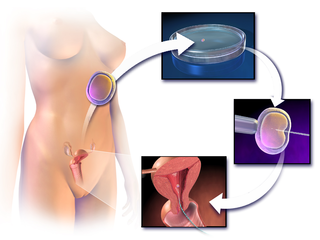 W
WIn vitro fertilisation (IVF) is a process of fertilisation where an egg is combined with sperm outside the body, in vitro. The process involves monitoring and stimulating a woman's ovulatory process, removing an ovum or ova from the woman's ovaries and letting sperm fertilise them in a liquid in a laboratory. After the fertilised egg (zygote) undergoes embryo culture for 2–6 days, it is implanted in the same or another woman's uterus, with the intention of establishing a successful pregnancy.
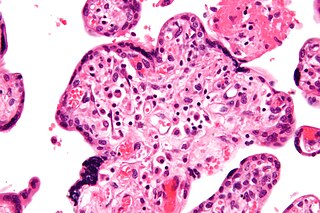 W
WIntrauterine growth restriction (IUGR) refers to poor growth of a fetus while in the mother's womb during pregnancy. The causes can be many, but most often involve poor maternal nutrition or lack of adequate oxygen supply to the fetus.
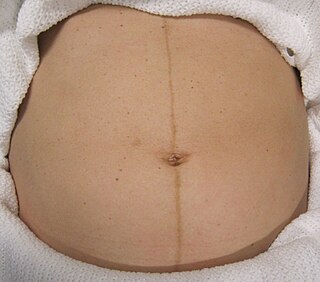 W
WLinea nigra, often referred to as a pregnancy line, is a linear hyperpigmentation that commonly appears on the abdomen. The brownish streak is usually about a centimeter (0.4 in) in width. The line runs vertically along the midline of the abdomen from the pubis to the umbilicus, but can also run from the pubis to the top of the abdomen.
 W
WA luteoma is a tumor that occurs in the ovaries during pregnancy. It is associated with an increase of sex hormones, primarily progesterone and testosterone. The size of the tumor can range from 1 to 25 cm in diameter, but is usually 6 to 10 cm in diameter and can grow throughout the duration of the pregnancy. However, luteomas are benign and resolve themselves after delivery. This type of tumor is rare with only about 200 documented cases; many of these cases were detected accidentally, so the actual rate of occurrence may be higher. The most obvious symptom of a luteoma is masculinization of the mother and the possible masculinization of the fetus. This occurs because of the release of testosterone by the luteoma. Testosterone is a sex hormone most abundant in men although small amounts are naturally present in women. Testosterone is responsible for the male characteristics such as deepening of the voice, growth of dark hair, and acne. While not life-threatening, the development of male characteristics associated with luteomas can cause visible changes in the mother and can have drastic effects on the formation of the fetus. Luteomas can cause the fetus to be born with an ambiguous sex, which, depending on how the parents prefer to raise the infant, may result in the parents choosing a sex for the fetus.
 W
WMale pregnancy is the incubation of one or more embryos or fetuses by male members of some species. Most species that reproduce by sexual reproduction are heterogamous—females producing larger gametes (ova) and males producing smaller gametes (sperm). In nearly all animal species, offspring are carried by the female until birth, but in fish of the family Syngnathidae, males perform this function.
 W
WMaternity clothing is worn by women as an adaptation to changes in body size during pregnancy. The evolution of maternity clothing began during the Middle Ages, and became fashionable as women became more selective about style and comfort in the types of maternity clothing they wore. Fashions were constantly changing over time, such as the high-waisted Empire silhouette style maternity dress that was fashionable at the turn of the 19th century, and the "wrapper" style dress of the Victorian era that a woman could simply wrap around herself and button up.
 W
WMedical imaging in pregnancy may be indicated because of pregnancy complications, intercurrent diseases or routine prenatal care.
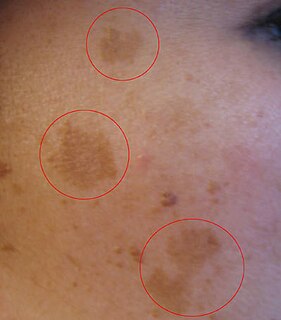 W
WMelasma is a tan or dark skin discoloration. Melasma is thought to be caused by sun exposure, genetic predisposition, hormone changes, and skin irritation. Although it can affect anyone, melasma is particularly common in women, especially pregnant women and those who are taking oral or patch contraceptives or hormone replacement therapy (HRT) medications.
 W
WNavicular cell is a boat-shaped benign epithelial cell seen in Pap smear. They are seen in pregnancy, second half of menstrual cycle, during menopause and in women using medroxyprogesterone acetate (depo-provera) for contraception. Navicular cells have folded edges, with a thickened outer rim of cytoplasm and an eccentric nucleus. They contain abundant glycogen in the cytoplasm, giving it a central yellow halo. The cytoplasm appears golden, refractile and granular under the microscope. In depo-provera users, the high progesterone levels result in more exfoliation of superficial squamous cells, thereby causing navicular cells to appear in Pap smear.
 W
WNeonatal infections are infections of the neonate (newborn) acquired during prenatal development or in the first four weeks of life. Neonatal infections may be contracted by mother to child transmission, in the birth canal during childbirth, or contracted after birth. Some neonatal infections are apparent soon after delivery, while others may develop in the postnatal period. Some neonatal infections such as HIV, hepatitis B, and malaria do not become apparent until much later.
 W
WNesting behaviour refers to an instinct or urge in pregnant animals associated with an increase of estradiol (E2) to prepare a home for the upcoming newborn(s). Nest building provides protection against predators and competitors that mean to exploit or kill infants. It also aids in family structure and is therefore influenced by different mating behaviours and social settings. It is found in a variety of animals such as birds, fish, squirrels, mice and pigs as well as humans. Nesting behaviour is seen mostly in pregnant females but such behaviour can also be observed in males and non-pregnant females. In these cases the behaviour is more for temperature control (thermoregulation).
 W
WPain management during childbirth is the treatment or prevention of pain that a woman may experience during labor and delivery. The amount of pain a woman feels during labor depends partly on the size and position of her baby, the size of her pelvis, her emotions, the strength of the contractions, and her outlook. Tension increases pain during labor. Virtually all women worry about how they will cope with the pain of labor and delivery. Childbirth is different for each woman and predicting the amount of pain experienced during birth and delivery can not be certain.
 W
WPlacenta accreta occurs when all or part of the placenta attaches abnormally to the myometrium. Three grades of abnormal placental attachment are defined according to the depth of attachment and invasion into the muscular layers of the uterus:Accreta – chorionic villi attach to the myometrium, rather than being restricted within the decidua basalis. Increta – chorionic villi invade into the myometrium. Percreta – chorionic villi invade through the perimetrium.
 W
WPostpartum confinement refers to a traditional practice following childbirth. Those who follow these customs typically begin immediately after the birth, and the confinement lasts for a culturally variable length: typically for one month or 30 days, up to 40 days, two months or 100 days. This postnatal recuperation can include "traditional health beliefs, taboos, rituals, and proscriptions." The practice used to be known as "lying-in", which, as the term suggests, centres around bed rest. In some cultures it may be connected to taboos concerning impurity after childbirth.
 W
WThe postpartum period begins immediately after childbirth as the mother's body, including hormone levels and uterus size, returns to a non-pregnant state. The terms puerperium, puerperal period, or immediate postpartum period are commonly used to refer to the first six weeks following childbirth. The World Health Organization (WHO) describes the postnatal period as the most critical and yet the most neglected phase in the lives of mothers and babies; most maternal and newborn deaths occur during this period. In scientific literature, the term is commonly abbreviated to Px, where x is a number; for example, "day P5" should be read as "the fifth day after birth". This is not to be confused with the medical nomenclature that uses G P to stand for number and outcomes of pregnancy.
 W
WThe Pregnancy Outcome Prediction (POP) Study is a prospective cohort study of 4,512 women that have never given birth recruited at the Rosie Hospital between January 2008 and July 2012.
 W
WPreimplantation factor, sometimes called PreImplantation Factor or simply PIF, is a peptide secreted by trophoblast cells prior to placenta formation in early embryonic development. Human embryos begin to express PIF at the 2-cell stage, with expression increasing by the morula stage and continuing to do so throughout the first trimester. Expression of preimplantation factor in the blastocyst was discovered as an early correlate of the viability of the eventual pregnancy. Preimplantation factor was identified in 1994 by a lymphocyte platelet-binding assay, where it was thought to be an early biomarker of pregnancy. It has a simple primary structure with a short sequence of fifteen amino acids without any known quaternary structure. A synthetic analogue of preimplantation factor that has an identical amino acid sequence and mimics the normal biological activity of PIF has been developed and is commonly used in research studies, particularly those that aim to study potential adult therapeutics.
 W
WProducts of conception, abbreviated POC, is a medical term used for the tissue derived from the union of an egg and a sperm. It encompasses anembryonic gestation which does not have a viable embryo.
 W
WSelf-Portrait on the sixth wedding anniversary (German: Selbstbildnis am 6. Hochzeitstag) is a painting by the German painter Paula Modersohn-Becker, one of the most important early expressionists, from the time of her stay in Paris in 1906.
 W
WStretch marks, also known as Striae or Striae distensae, are a form of scarring on the skin with an off-color hue. Over time they may diminish, but will not disappear completely. Stretch marks are caused by tearing of the dermis during periods of rapid growth of the body, such as during puberty or pregnancy. In pregnancy they usually form during the last trimester, and usually on the belly, but also commonly occur on the breasts, thighs, hips, lower back and buttocks; these are known as striae gravidarum. Stretch marks may also be influenced by the hormonal changes associated with puberty, pregnancy, bodybuilding, or hormone replacement therapy. There is no evidence that creams used during pregnancy prevent stretch marks. Once they have formed there is no clearly effective treatment, though various methods have been attempted and studied.
 W
WSurrogacy is an arrangement, often supported by a legal agreement, whereby a woman agrees to bear a child for another person or persons, who will become the child's parent(s) after birth.
 W
WThe legal aspects of surrogacy in any particular jurisdiction tend to hinge on a few central questions:Are surrogacy agreements enforceable, void, or prohibited? Does it make a difference whether the surrogate mother is paid (commercial) or simply reimbursed for expenses (altruistic)? What, if any, difference does it make whether the surrogacy is traditional or gestational surrogacy? Is there an alternative to post-birth adoption for the recognition of the intended parents as the legal parents, either before or after the birth?
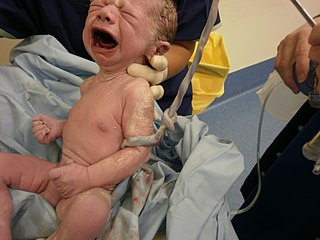 W
WUmbilical cord compression is the obstruction of blood flow through the umbilical cord secondary to pressure from an external object or misalignment of the cord itself. Cord compression happens in about one in 10 deliveries.